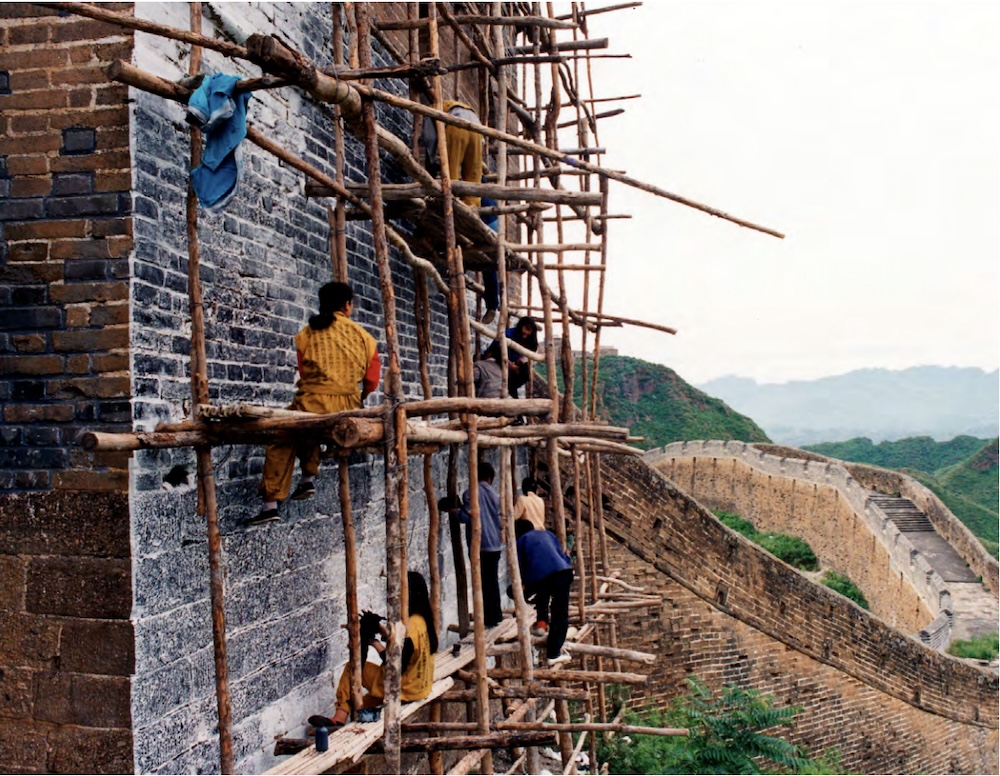
By Ilaria Puri Purini
The new installation of Xu Bing draws objects and ideas together — copies, singularities and divided histories. The Wall and the Road (1988–2024) is monumental as it draws these concepts together, and suggests we can participate in this monumentality.
Xu’s work is recursive and collaborative. It challenges us to think carefully about how repetition relates to diference. Part of the The Wall and the Road is a 22–meter–long ink rubbing of the Appian Way. The rubbing was done near the small province of Marino, a rural part of the Appian Way between mile X and XI, approximately 20 kilometers from Rome’s city center. It is far from the Rome that tourists have spent centuries reproducing and copying into pictures that have made Rome an eternal city; the Appian Way the mother to all roads.
Xu Bing returns to this rubbing technique, a practice of copying that reenacts his previous work. He used a similar technique approximately 35 years earlier for another work that documents texture, scale, and grandeur. Ghost Pounding the Wall (1988–1991) is a rubbing of a tower of the Great Wall of China. In the late 1980s and early 1990s, Xu collaborated with students and a local community of farmers. When he came to Rome, he found a community of Italian and Chinese students from Rome’s Accademia di Belle Arti and the Istituto Europeo di Design. Together, in the Roman spring sun and torrential rain, they worked to connect the wall to the road.

Fig. 1: Volunteers take rubbings of a tower at the Great Wall of China in the late 1980s (photograph courtesy of the Studio of Xu Bing)
For Xu, the technique of rubbing has a rich historical, cultural, and conceptual significance for which duplication is fundamental. Rubbing is a form of duplication used since the Han dynasty (202 BCE–9 CE, 25–220 CE). The technique has been modernized in Xu’s practice but follows ancient principles, first covering the surface with a thin layer of plastic, then with a large covering of Xuan paper, and lastly ‘poaching’ it with ink–soaked cotton pads. The rubbing is then gently peeled away from the surface, bearing the imprint of the walls. Fragile and vulnerable, it requires further manipulation to be exhibited. The technical realization of the works requires an intense and shared labor.
Folded into the technique is a multisensory history activated in the toil of pounding ink on paper–covered stone. Xu explains that this Chinese practice dates from the 2nd century BCE It bears a cultural attitude towards copying that is distinctively Chinese, one that traverses more modern and Western ideas of original and copy. Xu reflects on how copying hundreds of characters is fundamental to Chinese literacy, where learning to read and write means knowing how a sign bears the cultural history of other learners. Like the rubbings of the monuments in The Wall and the Road, each sign contains traces of past uses and the copy represents a transfer of evidence and a revelatory encounter. Rubbing requires skill and repetition. It combines the incremental diligence of laborers with the vision of artists.
The installation embraces creative engagement that spans 35 years. It is a practice that also layers an intimate history — felt at the level of biography and beginning when the world’s isolationism of the Chinese State contributed to Xu’s move to the United States to later become one of the most prominent Chinese artists of his generation. While living in New York, Xu’s work came to advocate Chinese cultural singularity in its struggle with Western materialism. In 2007, he returned to Beijing as Vice President of the Central Academy of Fine Arts, where he had begun his teaching career nearly 40 years earlier. As a resident at the American Academy in Rome, Xu presents a material engagement with ancient cultures, the Roman Empire and the Han Dynasty, whose divided monuments are connected through an artistic practice.
The historic context, the social structures, and the cultural experiences that form Western and Eastern cultures are diferent. Contacts between the two empires were sporadic and very limited. Bringing together a wall and road that are representative of the ancient civilizations that produced them is a way to reflect on history and what remains of time, power, and empire. We are invited to see geographies and eras folded together and to think about the ways in which we consider changes, and how we picture the infrastructures that underpin our freedoms.
Xu’s rubbings of unmoving monuments, transferred and made portable, stimulate and challenge our notions of a shared history. The rubbings themselves are not weak shadows of the originals but represent a method for transmission — a means to share culture. They are a communication device, a technology used to reflect on ancient technologies. Xu’s work occurs at a time when cultural exchanges between the East and the West are under pressure, and the times and places by which culture is understood can be limited. Nevertheless, monumental artworks can challenge as well as reinscribe conceptions of power and knowledge. And yet these imprints — copies of monuments and monumental copies — offer a unique opportunity to contemplate shared histories, and bring a lightness and possibility to how we picture ourselves.

Fig. 2: Students and volunteers collaborate with Xu on rubbings at the Appian Way (photograph courtesy of Xu Bing)